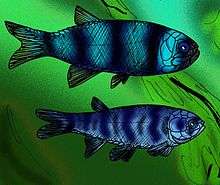Archaeomaenidae
| Archaeomaenidae Temporal range: Early Jurassic-Cretaceous | |
|---|---|
 | |
| Reconstructions of Madariscus and Archaeomaene | |
| Scientific classification | |
| Kingdom: | Animalia |
| Phylum: | Chordata |
| Superclass: | Osteichthyes |
| Class: | Actinopterygii |
| Subclass: | Neopterygii |
| Infraclass: | Holostei |
| Order: | Pachycormiformes |
| Family: | Archaeomaenidae |
| Genera | |
| |
Archaeomaenidae is an extinct family of pachycormid fish found in freshwater environments of Jurassic New South Wales of Australia, Asia, and Antarctica, and in Lower Cretaceous New South Wales.
Archaeomaenidae was originally erected for the species of Archaeomaene of the Talbragar fishbeds, but was then later expanded to include the other Talbragar fish genera of Aetheolepis and Aphnelepis, and then Madariscus when it was split from Archaeomaene. Archaeomaenidae has long been thought to be endemic to Australia, but, the Asian genera, Gurvanichthys of Mongolia,[1] and Zaxilepis of China,[2] and the Antarctic genus, Oreochima, strongly suggest that the family had a much farther, possibly global range than traditionally assumed.[3]
By the Early Cretaceous, only the genus Wadeichthys, and the archaeomaenids' apparent descendant, Koonwarria, survive, where both genera form important components of the vertebrate fauna of a polar lake in what is now Koonwarra, Victoria.[4] Archaeomaenids are unknown beyond the Koonwarra Lake fauna during the Cretaceous.
References
- ↑ Y. N. Jakovlev. 1986. Acipenseriformes, in Nasekomye v rannemelovykh ekosistemakh zapadnoy Mongolii. The Joint Soviet-Mongolian Palaeontological Expedition 28:178-182
- ↑ Su, Dezao. "New Early Jurassic actinopterygians from Weixin, Yunnan." Vertebrata Pal Asiatica 32.3 (1993): 151-165.
- ↑ Schaeffer, Bobb. A Jurassic fish from Antarctica. American Museum of Natural History, 1972.
- ↑ Waldman, Michael. Fish from the freshwater Lower Cretaceous of Victoria, Australia: with comments on the palaeo-environment. No. 9. Palaeontological Association, 1971.